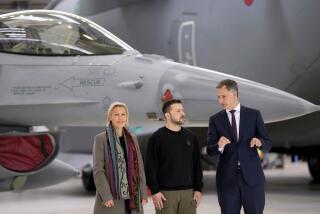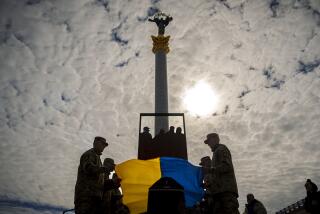Allies Dominate Air by Pounding Iraq’s Command Posts and Missiles : Tactics: Only 10 of 700 planes have been wrecked, but the fleet has been pinned down, the U.S. says.
- Share via
WASHINGTON — Three days into the Persian Gulf War, allied forces have effectively gained control of the airspace over Iraq and Kuwait even though they have confirmed destroying only 10 of Iraq’s approximately 700 military aircraft, Pentagon officials said Saturday.
The allies have immobilized the Iraqi air force by pounding Iraq’s air command-and-control facilities and ground-to-air missiles and by pinning or damaging its fighter planes in their concrete shelters. In addition, bombings by allied warplanes have cratered Iraqi runways, making them useless to enemy planes.
Iraqi President Saddam Hussein, apparently recognizing the allies’ enormous air superiority, has responded by sending few of his fighter planes up to engage the attackers. The allies have shot down 10 Iraqi planes in dogfights. No U.S., British or other coalition aircraft have been lost during air-to-air combat, the Pentagon said Saturday.
All nine allied aircraft that have been shot down--five U.S. planes, two British Tornadoes, one Italian Tornado and one Kuwaiti A-4 Skyhawk--were hit by Iraqi surface-to-air missiles and ground-to-air fire. One other U.S. plane crashed because of mechanical failure. American pilots returning to bases in Saudi Arabia have expressed surprise at how little resistance they encountered in the air from Iraqi fighters.
“The fact of the matter is that their air-defense system is no longer successful in major portions of the country,” Lt. Gen. Thomas W. Kelly, head of operations for the Joint Chiefs of Staff, said Saturday. “We feel that our air campaign is being about 80% successful, and we are very satisfied with that.”
Rather than going after individual planes, which would require heavy bombing attacks to penetrate reinforced underground shelters where they are housed, the U.S. and allied air campaign has made neutralizing Iraq’s missiles and anti-aircraft systems the first priority of the assault.
At the same time, the allied planes are conducting an intensive search for the mobile Scud missiles that Iraq has fired at Israel and Saudi Arabia in the last several days. Kelly said inclement weather in western Iraq--the area from which the Scud missiles were launched--has hindered the reconnaissance efforts that are seeking to pinpoint the launch sites.
Another factor in the allied air superiority is that only 85 of the aircraft in the Iraqi air force are relatively modern fighters capable of engaging allied planes in aerial combat. Many of the other planes are older Soviet and Chinese models considered no match for sophisticated U.S. and allied planes.
Iraq’s premier warplanes are its 30 Soviet-made MIG-29 “Fulcrums”--considered one of the best fighters in the world--and its 30 French Mirage F-1s, which are flown by some of Iraq’s top pilots. Thus far, the Iraqis have lost six MIGs, three Mirages and a MIG-23 Flogger.
But U.S. Rear Adm. John McConnell said focusing on the number of aircraft destroyed can be misleading in assessing the progress of such an air war.
“When discussing air forces, it’s useful to think about it in terms of air defense systems,” McConnell said. “Currently, their air defense system in the west is weakened significantly. . . .
“The Iraqis have never faced Western, well-trained forces, and they’re finding it a force they cannot contend with.”
During its decade-long war with neighboring Iran, Iraq gained virtual control of the air but proved incapable of inflicting great damage from its fighter planes, according to military analysts. One U.S. Marine general said that, from the air, the Iran-Iraq conflict “was almost one of comic relief.”
Another reason that more Iraqi planes have not been destroyed, Pentagon officials said, is that the Iraqis have moved some of them north because the allies are operating from the south. But, McConnell said, “If we go to the north, they’re going to run out of places to go.”
Paul Stares, an expert in military command and control at the Brookings Institution, expressed surprise at how few coalition planes have been lost during the approximately 4,700 missions flown over Iraq and Kuwait.
“It’s extraordinary,” Stares said. “With that number of sorties, you would expect that number of casualties from accidents alone.”
Nevertheless, Stares added, “We are now learning that these things aren’t as easy as they seem. Targets are harder to find and harder to attack. You can’t expect to hit every target the first time around. . . .
“It’s an extremely complex operation that takes a lot of time and a lot of skill to execute. It’s going to be a long campaign.”
More to Read
Sign up for Essential California
The most important California stories and recommendations in your inbox every morning.
You may occasionally receive promotional content from the Los Angeles Times.













